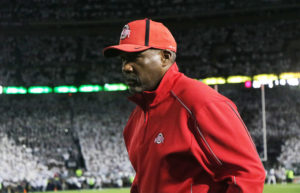Ohio State AD Smith Hopes Notre Dame Joins Big Ten In Future

There are three guarantees in life: Death, taxes and Notre Dame as an independent in college football. For the program’s entire history, the Fighting Irish have been unassociated with a conference, using their freedom to schedule games and create rivalries with several teams while dodging conference title games.
However, times in college football are changing, and Notre Dame might be facing its most significant opposition toward keeping its independence.
On June 30, USC and UCLA submitted applications to join the Big Ten — an offer the conference’s presidents and chancellors accepted unanimously. According to USC President Carol L. Folt and UCLA Chancellor Gene D. Block, the schools chose to align themselves with the Big Ten for academic and athletic purposes. Of course, the potential $100 million-plus payout from a new television deal played a factor, too.
Right now, Notre Dame doesn’t have to wager all and pledge its allegiance to the Big Ten, or any other conference for that matter. Still, Ohio State athletic director Gene Smith said on July 1 that he hopes his alma mater will consider making the same move as the Los Angeles-based schools.
“I love my alma mater, except when we play them in any sport,” Smith said. “I have always felt that they should be in a conference. I hope that they are considering that. I don’t know what the next step would be, but I’ve always shared that I hope they consider that opportunity, and I hope that it’s in the Big Ten.”
Smith was a defensive end at Notre Dame and won a national championship with the team in 1973 under Ara Parseghian. He played for one more season under Parseghian before finishing his career with Dan Davine at the helm. With an intimate background knowledge of South Bend, Smith understands the strong belief that surrounds Notre Dame’s independence in college football. Yet, he feels optimistic the Irish might entertain the idea.
“Who knows?” Smith asked with a chuckle. “They’ve been operating the way they’ve been operating for a long time. I’m not sure what would happen there.”
The Big Ten’s addition of Notre Dame would undoubtedly make headlines, as did the initial report of USC and UCLA leaving the Pac-12. Within minutes of Pac-12 Hotlines reporter Jon Wilner’s tweet that those schools could potentially join the Big Ten, national news organizations and local Columbus outlets started speculating where the conference might look next. Notre Dame was the most established program on lists that included Oregon, Washington and Stanford.
Pete Sampson, a staff writer for The Athletic and former editor and co-founder of Irish Illustrated with 21 years of experience covering Notre Dame football, recommends fans of the program brace themselves for a new normal. While the Fighting Irish won’t be forced to align themselves with a conference soon, they will need to plot their course for the years to come.
“The bill is not due today after USC and UCLA joined the Big Ten, with the sport hurtling toward two superconferences everyone else will be jockeying to join,” Sampson said. “But it would be inexcusable for athletics director Jack Swarbrick not to model a future for Notre Dame as full conference partners with USC, Ohio State and Michigan.”
Sampson cited Notre Dame’s strained athletic budget as his primary reason the school should join the Big Ten. According to On3sports, the Irish bring in $15 million annually from their partnership with NBC — a deal that runs through 2025. In 2020, the SEC schools earned $54.6 million because of their TV partnerships. The Big Ten institutions earned $46.1 million in payouts, while the ACC brought home a $36.1 million payout per school.
“The question for Swarbrick now is how far he can see ahead in the fog of realignment war,” Sampson said. “Because as much as Notre Dame values its independence, the cost-benefit analysis of that expense may be changing.”
As Ohio State and the other Big Ten schools gear for what should be a record-breaking TV rights deal, Notre Dame might find it hard to resist the potential payouts. Smith didn’t quantify those projected numbers for each school on July 1, but he knows it will turn eyes.
“It will be significant,” Smith said.